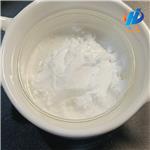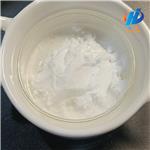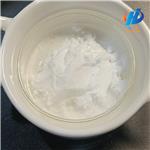- Gliquidone
-

- $50.00 / 1kg
-
2024-04-18
- CAS:33342-05-1
- Min. Order: 1kg
- Purity: 99.10%
- Supply Ability: 50000kg
- Gliquidone
-

- $50.00 / 1kg
-
2024-04-18
- CAS:33342-05-1
- Min. Order: 1kg
- Purity: 99.10%
- Supply Ability: 50000kg
- Gliquidone
-

- $50.00 / 1kg
-
2024-04-18
- CAS:33342-05-1
- Min. Order: 1kg
- Purity: 99.10%
- Supply Ability: 50000kg
|
| | Gliquidone Chemical Properties |
| Melting point | 179 °C | | density | 1.34±0.1 g/cm3(Predicted) | | storage temp. | Inert atmosphere,Room Temperature | | solubility | ≥22.4 mg/mL in DMSO; insoluble in H2O; ≥2.455 mg/mL in EtOH with gentle warming and ultrasonic | | form | powder to crystal | | pka | 5.12±0.10(Predicted) | | color | White to Almost white | | Merck | 14,4443 | | CAS DataBase Reference | 33342-05-1(CAS DataBase Reference) |
| Safety Statements | 24/25 | | RTECS | DB1584250 | | HS Code | 29147000 |
| | Gliquidone Usage And Synthesis |
| Oral hypoglycemic agents | Gliquidone is an oral hypoglycemic agent, and was called as the second generation sulfonylurea oral hypoglycemic drug together with glyburide, gliclazide and glipizide, primarily for the treatment of non-insulin-dependent (namely, II type) diabetes. Its mechanism of action is the same as other sulfonylurea drugs and can stimulate insulin secretion from pancreatic β cells, and can enhance the action of insulin, enhance the sensitivity of tissues to insulin action, increase the number of insulin receptor and strengthen post-receptor action of insulin. During the early phase of treatment, it is mainly used for promoting the secretion of endogenous insulin; after a period of time of treatment, its main role is to improve the sensitivity of peripheral tissues to insulin. Diabetic nephropathy is one of the late complications of diabetes while gliquidone is the only sulfonylurea drugs that not affected by renal function and therefore can be applied to diabetic patients with impaired renal function. It is the primary-choice of drug for the treatment of patients of non-insulin dependent diabetes accompanied with insufficiency of renal function.
Gliquidone is characterized by short duration of action and seldom undergoing of renal excretion with a small dose being able to control postprandial blood glucose. Oral absorption is quick and complete. After the first oral administration of 30mg, the plasma concentration reaches its peak value, 500~700μg/L after 2 to 3 hours. The efficacy onset occurs at 1 hour after administration, the maximal effect can be extended up to 2 to 3 hours with the duration of 8 hours and the plasma protein binding rate being 99% and the half-life of about 1.5 hours. It is mainly metabolized in the liver through hydroxylation or demethylation with its metabolites having no significant hypoglycemic activity and most of them being discharged through feces via biliary while only 5% being subject to renal excretion. This product has mild effect and can be subject to dose adjustment timely based on blood sugar or urine glucose and rarely cause hypoglycemia reaction. It is suitable for the treatment of adult-type mild, moderate diabetes which can’t be simply treated through diet, especially for patients with renal insufficiency.
| | Diabetes | Diabetes is a group of syndrome of carbohydrate, fat, water and electrolyte metabolic disorder caused by the interaction of genetic and environmental factors, absolute or relative lack of insulin, and reduced cellular insulin sensitivity. According to the suggestion of ADA (in 1997) and WHO (in 1999), the diabetes are divided into four types, namely type 1 diabetes, type 2 diabetes, other specific types, and gestational diabetes. The vast majority belongs to type 2 diabetes (non-insulin-dependent diabetes mellitus, NIDDM), type 1 diabetes (insulin-dependent, IDDM) accounted for only 10% to 15%. The main clinical manifestations: polydipsia, polyphagia, polyuria, weight loss, fatigue, etc., advanced case is often accompanied with cataracts, abnormal reflexes in depth of feeling, urinary retention and skin infections. Type 1 " three polys and one little " is more obvious and is susceptible; the majority of patients with type 2 have no typical performances and is mainly in the form of complications or complications. Common complication mainly includes diabetic ketoacidosis and diabetic nonketotic hyperosmotic syndrome.
The above information is edited by the chemicalbook of Dai Xiongfeng.
| | Medicine interactions | The hypoglycemic effect of gliquidone can be enhanced by salicylates, sulfonamides, phenylbutazone, anti-tuberculosis drugs, tetracyclines, monoamine oxidase inhibitors, β receptor blockers and cyclophosphamide.
Combination with chlorpromazine, sympathomimetic drugs, corticosteroids, thyroid hormones, oral contraceptives and niacin preparations can reduce the hypoglycemic effect of this product.
| | Side effects | This product can be well tolerated. There is rare case of hypoglycemia during the treatment. There are only individual cases of patients who get gastrointestinal symptoms and skin allergy. Rare symptoms also include rash, jaundice, liver damage, bone marrow suppression, neutropenia, thrombocytopenia psychosis.
| | Precautions | 1. Only 5% of this product is excreted through the kidneys. Therefore, for patients of diabetes with mild to moderate renal insufficiency, it is significantly better to adopt gliquidone rather than other sulfonylurea drug. However, for patients of severe renal dysfunction, insulin is still appropriate. Patients of pregnancy and those who are allergic to sulfonylureas, patients of insulin-dependent diabetes mellitus, patients of pre-coma and coma of diabetes, diabetic patients with acidosis or ketosis should be banned.
2. Children and lactating women should apply with caution. During medication, elderly should start from small dose and gradually adjust the dose.
3. In case of hypoglycemia reaction, the patients should immediately have carbohydrates diet. If hypoglycemia continues, the patients should consider discontinuing.
| | Uses | It is a kind of hypoglycemic agents and can be used for the treatment of non-insulin-dependent diabetes.
| | Description | Gliquidone is a second generation sulfonylurea that selectively inhibits ATP-sensitive potassium channel currents (IKATP) in pancreatic β-cells (IC50s = 0.45, 119.1, and 149.7 μM for HIT-T15 cells, cardiomyocytes, and vascular smooth muscle cells, respectively). It is also a peroxisome proliferator-activated receptor γ (PPARγ) agonist (EC50 = 10 μM in a transactivation assay). Gliquidone (0.2 nmol/g) decreases plasma levels of D-glucose and stimulates insulin release in anesthetized rats. It decreases blood glucose levels, serum alkaline phosphatase (ALP), aspartate aminotransferase (AST), and alanine aminotransferase (ALT) activities, and hepatic lipid peroxidation and increases hepatic glutathione (GSH) levels in a rat model of diabetes induced by streptozotocin (STZ; ) when administered at a dose of 10 mg/kg. | | Originator | Glurenorm,Thornae,W. Germany,1975 | | Uses | Gliquidone is an anti diabetic agent used in the treatment of hypoglycemia which leads to an increased risk in diabetic cardiovascular disease. Also used in the treatment diabetic nephropathy. | | Definition | ChEBI: 1-cyclohexyl-3-[4-[2-(7-methoxy-4,4-dimethyl-1,3-dioxo-2-isoquinolinyl)ethyl]phenyl]sulfonylurea is a member of isoquinolines. | | Manufacturing Process | A mixture consisting of 4 grams of 1,2,3,4-tetrahydro-4,4-dimethyl-7-
methoxy-isochromanedione-(1,3) (MP 95° to 97°C), 2.53 grams of 4-
aminosulfonyl-phenyl-(2)-ethylamine and 150 ml of xylene was heated for 2
hours at its boiling point in an apparatus provided with a water separator.
Thereafter, the reaction mixture was allowed to cool and was then vacuum�filtered, and the filter cake was recrystallized from n-propanol in the presence
of activated charcoal. 2.9 grams (58% of theory) of 1,2,3,4-tetrahydro-4,4-
dimethyl-2-[p-aminosulfonylphenyl-(2)-ethyl]-7-methoxy-isoquinolinedione-
(1,3), MP 203° to 205°C, of the formula below were obtained.
32.2 grams of 1,2,3,4-tetrahydro-4,4-dimethyl-2-[p-aminosulfonylphenyl-(2)-ethyl]-7-methoxy-isoquinolinedione-(1,3) were dissolved in 700 ml of
dimethylformamide, 9.1 grams of potassium tert-butylate were added to the
solution, and, while cooling the mixture with ice, 14.9 grams of cyclohexyl
isocyanate were added dropwise thereto.
Subsequently, the reaction mixture was stirred for 5 hours on an ice bath and
was then allowed to stand overnight at -2°C. Thereafter, the reaction solution
was admixed with water, the precipitate formed thereby was separated by
vacuum-filtration, the filtrate was admixed with more water, and the aqueous
solution was acidified with 2N hydrochloric acid. A greasy substance
precipitated out which crystallized after a brief period of contact with boiling
methanol. 2.6 grams (85% of theory) of 1,2,3,4-tetrahydro-2-[p-(N'-
cyclohexyl-ureido-N-sulfonyl)-phenethyl]-4,4-dimethyl-7-methoxy�isoquinolinedione-(1,3), MP 180° to 182°C, were obtained. | | Therapeutic Function | Oral hypoglycemic | | Hazard | Low toxicity by ingestion. A reproductive
hazard. | | references | [1]. ocaña m, del pozo e, baeyens jm. gliquidone, an atp-dependent k+ channel antagonist, antagonizes morphine-induced hypermotility. eur j pharmacol, 1993, 239(1-3): 253-255.
[2]. ocaña m, baeyens jm. role of atp-sensitive k+ channels in antinociception induced by r-pia, an adenosine a1 receptor agonist. naunyn schmiedebergs arch pharmacol, 1994, 350(1): 57-62.
[3]. von nicolai h, brickl r, eschey h, et al. duration of action and pharmacokinetics of the oral antidiabetic drug gliquidone in patients with non-insulin-dependent (type 2) diabetes mellitus. arzneimittelforschung, 1997, 47(3): 247-252.
[4]. tuerk tr, bandur s, nuernberger j, et al. gliquidone therapy of new-onset diabetes mellitus after kidney transplantation. clin nephrol, 2008, 70(1): 26-32. |
| | Gliquidone Preparation Products And Raw materials |
|